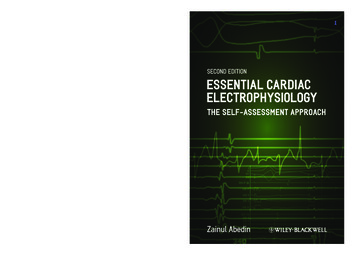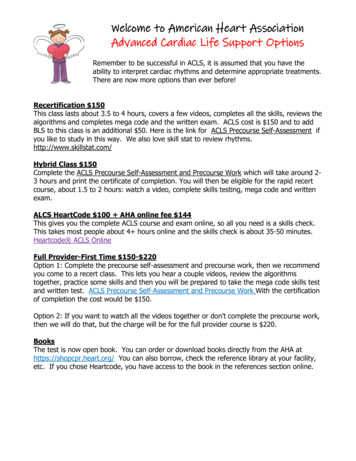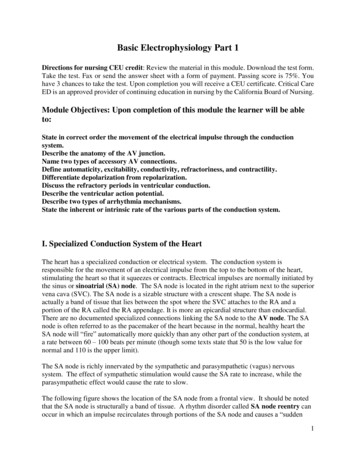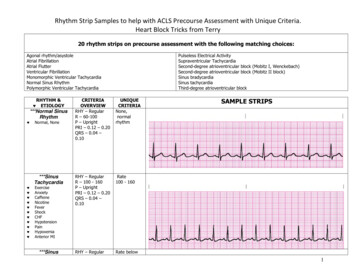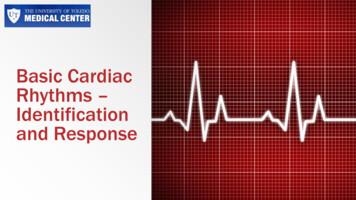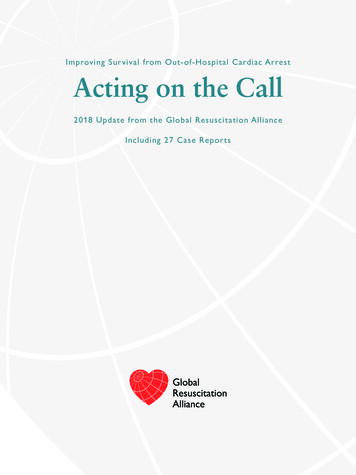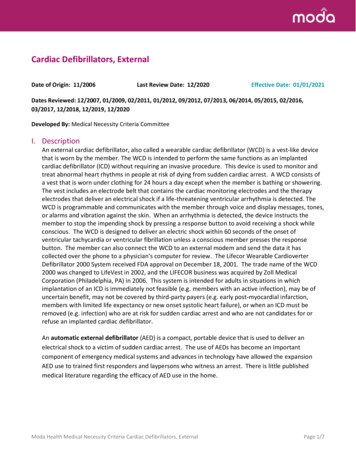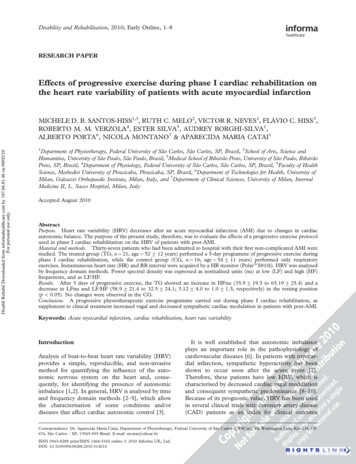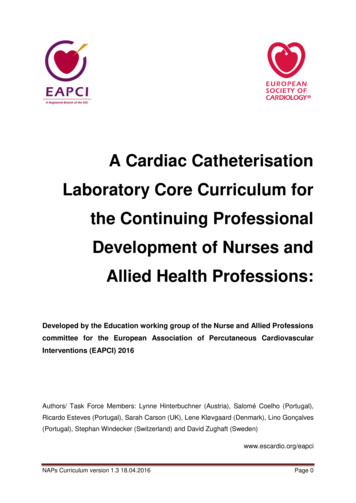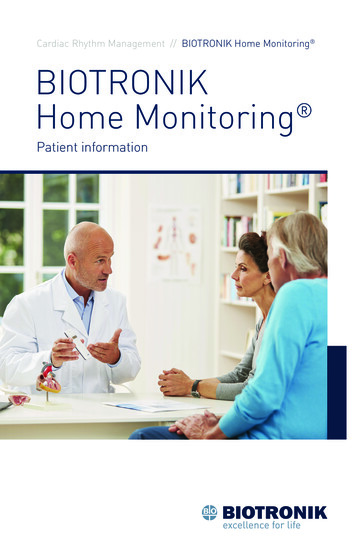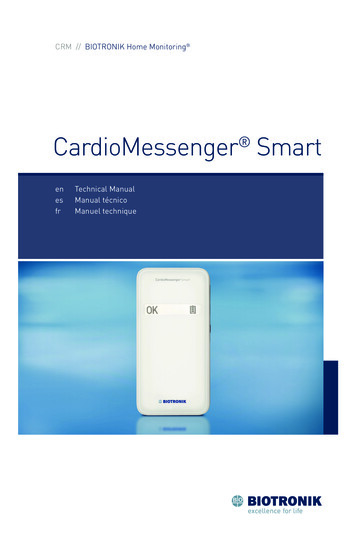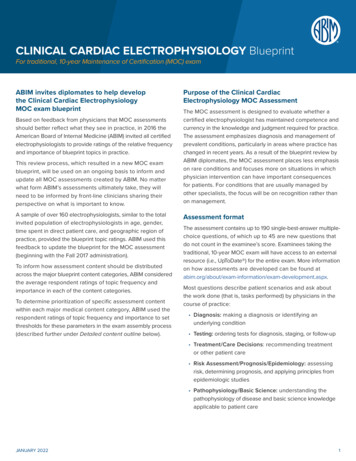
Transcription
CLINICAL CARDIAC ELECTROPHYSIOLOGY BlueprintFor traditional, 10-year Maintenance of Certification (MOC) examABIM invites diplomates to help developthe Clinical Cardiac ElectrophysiologyMOC exam blueprintBased on feedback from physicians that MOC assessmentsshould better reflect what they see in practice, in 2016 theAmerican Board of Internal Medicine (ABIM) invited all certifiedelectrophysiologists to provide ratings of the relative frequencyand importance of blueprint topics in practice.This review process, which resulted in a new MOC examblueprint, will be used on an ongoing basis to inform andupdate all MOC assessments created by ABIM. No matterwhat form ABIM’s assessments ultimately take, they willneed to be informed by front-line clinicians sharing theirperspective on what is important to know.A sample of over 160 electrophysiologists, similar to the totalinvited population of electrophysiologists in age, gender,time spent in direct patient care, and geographic region ofpractice, provided the blueprint topic ratings. ABIM used thisfeedback to update the blueprint for the MOC assessment(beginning with the Fall 2017 administration).To inform how assessment content should be distributedacross the major blueprint content categories, ABIM consideredthe average respondent ratings of topic frequency andimportance in each of the content categories.To determine prioritization of specific assessment contentwithin each major medical content category, ABIM used therespondent ratings of topic frequency and importance to setthresholds for these parameters in the exam assembly process(described further under Detailed content outline below).Purpose of the Clinical CardiacElectrophysiology MOC AssessmentThe MOC assessment is designed to evaluate whether acertified electrophysiologist has maintained competence andcurrency in the knowledge and judgment required for practice.The assessment emphasizes diagnosis and management ofprevalent conditions, particularly in areas where practice haschanged in recent years. As a result of the blueprint review byABIM diplomates, the MOC assessment places less emphasison rare conditions and focuses more on situations in whichphysician intervention can have important consequencesfor patients. For conditions that are usually managed byother specialists, the focus will be on recognition rather thanon management.Assessment formatThe assessment contains up to 190 single-best-answer multiplechoice questions, of which up to 45 are new questions thatdo not count in the examinee’s score. Examinees taking thetraditional, 10-year MOC exam will have access to an externalresource (i.e., UpToDate ) for the entire exam. More informationon how assessments are developed can be found .aspx.Most questions describe patient scenarios and ask aboutthe work done (that is, tasks performed) by physicians in thecourse of practice: Diagnosis: making a diagnosis or identifying anunderlying condition Testing: ordering tests for diagnosis, staging, or follow-up Treatment/Care Decisions: recommending treatmentor other patient care Risk Assessment/Prognosis/Epidemiology: assessingrisk, determining prognosis, and applying principles fromepidemiologic studies Pathophysiology/Basic Science: understanding thepathophysiology of disease and basic science knowledgeapplicable to patient careJANUARY 20221
Clinical scenarios presented take place in outpatient orinpatient settings as appropriate to a typical electrophysiologypractice. Clinical information may include pictorial material,radiographs, electrocardiograms, echocardiograms, venograms,fluoroscopy images, and other media to illustrate relevantpatient findings.A tutorial, including examples of ABIM assessment questionformat, can be found at al.aspx.How the blueprint ratings are used to assemblethe MOC assessmentBlueprint reviewers provided ratings of relative frequency inpractice for each of the detailed content topics in the blueprintand provided ratings of the relative importance of the topicsfor each of the tasks described in Assessment format above.In rating importance, reviewers were asked to consider factorssuch as the following: High risk of a significant adverse outcome Cost of care and stewardship of resourcesContent distribution Common errors in diagnosis or managementListed below are the major medical content categories thatdefine the domain for the Clinical Cardiac Electrophysiologytraditional, 10-year MOC exam. The relative distribution ofcontent is expressed as a percentage of the total assessment.To determine the content distribution, ABIM considered theaverage respondent ratings of topic frequency and importance.Informed by these data, the Clinical Cardiac ElectrophysiologyApproval Committee and Cardiovascular Board havedetermined the medical content category targets shown below. Effect on population healthCONTENT CATEGORYTARGET %Basic Physiology, Anatomy,Pharmacology, and Genetics10%Clinical Arrhythmias: Core Concepts6%Clinical Arrhythmias: Bradycardias6%Clinical Arrhythmias: Atrial14%Clinical Arrhythmias:Supraventricular Tachycardias17%Clinical Arrhythmias: Ventricular17%Devices22%Clinical Scenarios and Syndromes8%TotalJANUARY 2022 Effect on quality of life When failure to intervene by the physician deprives apatient of significant benefitFrequency and importance were rated on a three-point scalecorresponding to low, medium, or high. The median importanceratings are reflected in the Detailed content outline below.The Clinical Cardiac Electrophysiology Approval Committeeand Cardiovascular Board, in partnership with the physiciancommunity, have set the following parameters for selectingMOC assessment questions according to the blueprintreview ratings: At least 75% of questions will address high-importancecontent (indicated in green) No more than 25% of questions will address mediumimportance content (indicated in yellow) No exam questions will address low-importance content(indicated in red)Independent of the importance and task ratings, no more than20% of questions will address low-frequency content (indicatedby “LF” following the topic description).100%2
The content selection priorities below are applicable beginning with the Fall 2017 traditional, 10-year MOC exam and are subject tochange in response to future blueprint review.Note: The same topic may appear in more than one medical content category.Detailed content outline for the Clinical Cardiac Electrophysiology traditional, 10-year MOC exam–M edium Importance: No more than 25%of questions will address topics and taskswith this designation.–H igh Importance: At least 75% of questionswill address topics and tasks with thisdesignation.–L ow Importance: No questions willaddress topics and tasks withthis designation.LF – Low Frequency: No more than 20% of questions will address topics with this designation, regardless of task or importance.BASIC PHYSIOLOGY, ANATOMY,PHARMACOLOGY, AND GENETICS(10% of exam)DiagnosisTestingTreatment/Care DecisionsRisk asic ScienceCELLULAR ELECTROPHYSIOLOGY ( 2% of exam)Action potentialsLFIon channels and currentsLFReceptorsLFNot ApplicableNot ApplicableNot ApplicableNot ApplicableGap junctionsCARDIAC ANATOMY ( 2% of exam)Cardiac anatomyNot ApplicableCARDIAC TISSUE PHYSIOLOGY (5% of exam)Refractory periodsNot ApplicableNeuronal control – sympatheticnervous system and catecholaminesNot ApplicableAtrioventricular (AV) andventriculoatrial (VA) conductiondelay and blockMechanisms of arrhythmiasNot ApplicableNot ApplicableNot ApplicableElectrical and structural remodelingNot ApplicableRepolarization – dispersion andreserveNot ApplicableOther physiologic phenomena(retrograde block, ACE inhibitors,fractionated electrograms,pseudonormalization)JANUARY 2022Not Applicable*This topic was added or revised after the blueprint was reviewed by the Clinical Cardiac Electrophysiology diplomates; it has been provisionallyrated by the Cardiovascular Board Clinical Cardiac Electrophysiology Approval Committee, pending the next blueprint review process.3
–H igh Importance: At least 75% of questionswill address topics and tasks with thisdesignation.–M edium Importance: No more than 25%of questions will address topics and taskswith this designation.–L ow Importance: No questions willaddress topics and tasks withthis designation.LF – Low Frequency: No more than 20% of questions will address topics with this designation, regardless of task or importance.BASIC PHYSIOLOGY, ANATOMY,PHARMACOLOGY, AND GENETICScontinued (10% of exam)DiagnosisTestingTreatment/Care DecisionsRisk asic SciencePHARMACOLOGY (3% of exam)Not ApplicablePharmacokineticsNot ApplicableNot ApplicableUse and reverse use dependenceNot ApplicableProperties of antiarrhythmic agentsNot ApplicableGENETICS ( 2% of exam)Not ApplicableIon channelsNon-ion channelsNot ApplicableLFCLINICAL ARRHYTHMIAS:CORE CONCEPTS(6% of exam)DiagnosisTestingTreatment/Care DecisionsRisk asic ScienceRECOGNITION OF ARTIFACT ( 2% of exam)Not ApplicableRecognition of artifactPACING, SIGNAL RECORDING, AND MAPPING SYSTEMS (ELECTROPHYSIOLOGY LABORATORY) ( 2% of exam)Pacing, signal recording, andmapping systems (electrophysiologylaboratory)Not ApplicableNot ApplicableNONINVASIVE TESTING (2% of exam)Not ApplicableIndicationsNot ApplicableNot ApplicableTilt-table testingInterpretation of wide QRStachycardiasNot ApplicableAmbulatory electrocardiographicmonitoringNot ApplicableNot ApplicableINVASIVE ELECTROPHYSIOLOGIC TESTING (2% of exam)Not ApplicableIndicationsNot ApplicableInterpretationsBIOPHYSICS OF ABLATION ( 2% of exam)Biophysics of ablationJANUARY 2022Not ApplicableNot Applicable*This topic was added or revised after the blueprint was reviewed by the Clinical Cardiac Electrophysiology diplomates; it has been provisionallyrated by the Cardiovascular Board Clinical Cardiac Electrophysiology Approval Committee, pending the next blueprint review process.4
–H igh Importance: At least 75% of questionswill address topics and tasks with thisdesignation.–M edium Importance: No more than 25%of questions will address topics and taskswith this designation.–L ow Importance: No questions willaddress topics and tasks withthis designation.LF – Low Frequency: No more than 20% of questions will address topics with this designation, regardless of task or importance.CLINICAL ARRHYTHMIAS:CORE CONCEPTScontinued (6% of exam)DiagnosisTestingTreatment/Care DecisionsRisk asic ScienceTRANSSEPTAL CATHETERIZATION AND PERICARDIAL ACCESS ( 2% of exam)Transseptal catheterization andpericardial accessNot ApplicableNot ApplicableCARDIAC AND INTRACARDIAC IMAGING ( 2% of exam)Not ApplicableCardiac and intracardiac imagingCLINICAL ARRHYTHMIAS:BRADYCARDIAS(6% of exam)DiagnosisTestingNot ApplicableTreatment/Care DecisionsRisk asic ScienceSINUS NODE DYSFUNCTION ( 2% of exam)Not ApplicableSinus node dysfunctionNot ApplicableAV BLOCK (4% of exam)ECGs – monitoring and telemetryInvasive electrophysiologic studiesESCAPE AND ACCELERATED RHYTHMS ( 2% of exam)Not ApplicableEscape and accelerated rhythmsCLINICAL ARRHYTHMIAS: ATRIAL(14% of exam)DiagnosisTestingNot ApplicableTreatment/Care DecisionsRisk asic ScienceATRIAL FIBRILLATION (6% of exam)Not ApplicableMechanism and etiologyNot ApplicableECGs – monitoring and telemetryPharmacologic treatmentNot ApplicablePostoperative atrial fibrillationNot ApplicableNot ApplicableStroke preventionNot ApplicableNot ApplicableJANUARY 2022Not Applicable*This topic was added or revised after the blueprint was reviewed by the Clinical Cardiac Electrophysiology diplomates; it has been provisionallyrated by the Cardiovascular Board Clinical Cardiac Electrophysiology Approval Committee, pending the next blueprint review process.5
–H igh Importance: At least 75% of questionswill address topics and tasks with thisdesignation.–M edium Importance: No more than 25%of questions will address topics and taskswith this designation.–L ow Importance: No questions willaddress topics and tasks withthis designation.LF – Low Frequency: No more than 20% of questions will address topics with this designation, regardless of task or importance.CLINICAL ARRHYTHMIAS: ATRIALcontinued (14% of exam)DiagnosisTestingTreatment/Care DecisionsRisk asic ScienceATRIAL FIBRILLATION continued (6% of exam)Not ApplicableCardioversionNot ApplicableNot ApplicableCatheter ablationSurgical ablationNot ApplicableNot ApplicableAV junction ablationNot ApplicableNot ApplicableATRIAL FLUTTER (4% of exam)Not ApplicableECGs – monitoring and telemetryPharmacologic treatmentNot ApplicableNot ApplicableStroke preventionNot ApplicableNot ApplicableCardioversionNot ApplicableNot ApplicableCavotricuspid isthmus (CTI)dependent atrial flutterNot ApplicableAtypical right atrial flutterNot ApplicableNot ApplicableNot ApplicableNot ApplicableAtypical left atrial flutterFOCAL ATRIAL TACHYCARDIAS (4% of exam)Not ApplicableECGs – monitoring and telemetryNot ApplicablePharmacologic treatment(17% of exam)Not ApplicableNot ApplicableCatheter ablationCLINICAL ARRHYTHMIAS:SUPRAVENTRICULARTACHYCARDIASNot ApplicableDiagnosisTestingNot ApplicableTreatment/Care DecisionsRisk asic ScienceACCESSORY PATHWAY SYNDROMES (11% of exam)ECGs – monitoring and telemetryPharmacologic treatmentElectrophysiologic studies inventricular preexcitationNot ApplicableNot ApplicableNot ApplicableNot ApplicableElectrophysiologic studies inorthodromic AVRT (typical andatypical pathways)JANUARY 2022*This topic was added or revised after the blueprint was reviewed by the Clinical Cardiac Electrophysiology diplomates; it has been provisionallyrated by the Cardiovascular Board Clinical Cardiac Electrophysiology Approval Committee, pending the next blueprint review process.6
–H igh Importance: At least 75% of questionswill address topics and tasks with thisdesignation.–M edium Importance: No more than 25%of questions will address topics and taskswith this designation.–L ow Importance: No questions willaddress topics and tasks withthis designation.LF – Low Frequency: No more than 20% of questions will address topics with this designation, regardless of task or importance.CLINICAL ARRHYTHMIAS:SUPRAVENTRICULARTACHYCARDIAScontinued (17% of exam)DiagnosisTestingTreatment/Care DecisionsRisk asic ScienceACCESSORY PATHWAY SYNDROMES continued (11% of exam)Electrophysiologic studies inantidromic AVRT (typical andatypical pathways)Not ApplicableNot ApplicableAblation of accessory pathwaysFasciculoventricular pathwaysLFNot ApplicableMultiple pathwaysLFNot ApplicableAV NODAL REENTRY TACHYCARDIA (AVNRT) (5% of exam)Typical AVNRT (ECGs, pharmacologictreatment, intracardiac recordings,and ablation)Atypical AVNRT (ECGs, pharmacologictreatment, intracardiac recordings,and ablation)JUNCTIONAL TACHYCARDIAS ( 2% of exam)Not ApplicableECGs – monitoring and telemetryPharmacologic treatmentLFInterpretation of electrophysiologyrecordingsAblationNot ApplicableNot ApplicableNot ApplicableLFNot ApplicableNot ApplicableNot ApplicableMULTIPLE SVT MECHANISMS ( 2% of exam)Not ApplicableECGs – monitoring and telemetryPharmacologic treatmentNot ApplicableInterpretation of electrophysiologyrecordingsAblationJANUARY 2022Not ApplicableNot ApplicableNot ApplicableNot Applicable*This topic was added or revised after the blueprint was reviewed by the Clinical Cardiac Electrophysiology diplomates; it has been provisionallyrated by the Cardiovascular Board Clinical Cardiac Electrophysiology Approval Committee, pending the next blueprint review process.7
–H igh Importance: At least 75% of questionswill address topics and tasks with thisdesignation.–M edium Importance: No more than 25%of questions will address topics and taskswith this designation.–L ow Importance: No questions willaddress topics and tasks withthis designation.LF – Low Frequency: No more than 20% of questions will address topics with this designation, regardless of task or importance.CLINICAL ARRHYTHMIAS:VENTRICULAR(17% of exam)DiagnosisTestingTreatment/Care DecisionsRisk asic ScienceECGS AND AMBULATORY MONITORING (4% of exam)Not ApplicableAmbulatory monitor recordingsECG localization – prematureventricular complexes (PVC) and VTNot ApplicableNot ApplicableCORE CONCEPTS (5.5% of exam)Indications for invasiveelectrophysiologic studiesNot ApplicableInterpretation of intracardiacrecordingsNot ApplicableNot ApplicablePharmacologic treatmentNot ApplicableNot ApplicableNot ApplicablePrinciples of entrainmentVENTRICULAR TACHYCARDIAS AND ISCHEMIC HEART DISEASE (2% of exam)Not ApplicablePhysiologyNot ApplicableEndocardial ablationNot ApplicableEpicardial ablationLFNot ApplicableNot ApplicableArrhythmias in patients with a leftventricular assist device (LVAD)*LFNot ApplicableNot ApplicableHemodynamic support duringablation*LFNot ApplicableNot ApplicableVENTRICULAR TACHYCARDIAS AND NONISCHEMIC CARDIOMYOPATHY ( 2% of exam)Not ApplicablePhysiologyEndocardial ablationNot ApplicableNot ApplicableNot ApplicableEpicardial ablationLFNot ApplicableArrhythmias in patients with a leftventricular assist device (LVAD)*LFNot ApplicableNot ApplicableHemodynamic support duringablation*LFNot ApplicableNot ApplicableVENTRICULAR TACHYCARDIAS AND PREMATURE VENTRICULAR COMPLEXES AND THE NORMAL HEART (3% of exam)PhysiologyNot ApplicableEndocardial ablationNot ApplicableNot ApplicableNot ApplicableNot ApplicableEpicardial ablationJANUARY 2022LF*This topic was added or revised after the blueprint was reviewed by the Clinical Cardiac Electrophysiology diplomates; it has been provisionallyrated by the Cardiovascular Board Clinical Cardiac Electrophysiology Approval Committee, pending the next blueprint review process.8
–H igh Importance: At least 75% of questionswill address topics and tasks with thisdesignation.–M edium Importance: No more than 25%of questions will address topics and taskswith this designation.–L ow Importance: No questions willaddress topics and tasks withthis designation.LF – Low Frequency: No more than 20% of questions will address topics with this designation, regardless of task or importance.CLINICAL ARRHYTHMIAS:VENTRICULARcontinued (17% of exam)DiagnosisTestingTreatment/Care DecisionsRisk asic ScienceVENTRICULAR FIBRILLATION AND POLYMORPHIC VENTRICULAR TACHYCARDIAS ( 2% of exam)Not ApplicablePhysiologyNot ApplicableECGs – monitoring and telemetryNot ApplicableNot ApplicablePharmacologic treatmentNot ApplicableBradycardia-dependentNot ApplicableNot ApplicableDrug-inducedNot ApplicableNot ApplicableIschemicNot ApplicableNot ApplicableIndications for invasiveelectrophysiologic studiesNot ApplicableAblationNot ApplicableLFDEVICES(22% of exam)Not ApplicableDiagnosisTestingNot ApplicableTreatment/Care DecisionsRisk asic ScienceGENERAL CONCEPTS ( 2% of exam)Not ApplicableElectromagnetic interferenceBiophysics and bioengineeringLFNot ApplicableNot ApplicableNot ApplicableLead extractionNot ApplicableInfectionAutomatic external and wearabledefibrillatorsNot ApplicableNot ApplicableNot ApplicablePACEMAKERS (7% of exam)Not ApplicableIndicationsNot ApplicableImplantation techniquesProgramming and follow-upNot ApplicableComplicationsNot ApplicableLeadless pacing*JANUARY 2022LFNot ApplicableNot ApplicableNot ApplicableNot ApplicableNot ApplicableNot Applicable*This topic was added or revised after the blueprint was reviewed by the Clinical Cardiac Electrophysiology diplomates; it has been provisionallyrated by the Cardiovascular Board Clinical Cardiac Electrophysiology Approval Committee, pending the next blueprint review process.9
–M edium Importance: No more than 25%of questions will address topics and taskswith this designation.–H igh Importance: At least 75% of questionswill address topics and tasks with thisdesignation.–L ow Importance: No questions willaddress topics and tasks withthis designation.LF – Low Frequency: No more than 20% of questions will address topics with this designation, regardless of task or importance.DEVICEScontinued (22% of exam)DiagnosisTestingTreatment/Care DecisionsRisk asic ScienceIMPLANTABLE CARDIOVERTER-DEFIBRILLATOR (ICD) THERAPY (8% of exam)IndicationsNot ApplicableNot ApplicableImplantation techniquesNot ApplicableNot ApplicableECGs – monitoring and telemetryNot ApplicableNot ApplicableProgrammingNot ApplicableNot ApplicableFollow-upNot ApplicableComplicationsNot ApplicableSubcutaneous implantabledefibrillator*Not ApplicableNot ApplicableNot ApplicableCARDIAC RESYNCHRONIZATION (5% of exam)Not ApplicableIndicationsImplantation techniquesNot ApplicableNot ApplicableNot ApplicableECGs – monitoring and telemetryNot ApplicableNot ApplicableProgrammingNot ApplicableNot ApplicableLeadsNot ApplicableNot ApplicableFollow-upNot ApplicableNot ApplicableNot ApplicableComplicationsINSERTABLE LOOP RECORDERS ( 2% of exam)Insertable loop recordersJANUARY 2022Not ApplicableNot Applicable*This topic was added or revised after the blueprint was reviewed by the Clinical Cardiac Electrophysiology diplomates; it has been provisionallyrated by the Cardiovascular Board Clinical Cardiac Electrophysiology Approval Committee, pending the next blueprint review process.10
–H igh Importance: At least 75% of questionswill address topics and tasks with thisdesignation.–M edium Importance: No more than 25%of questions will address topics and taskswith this designation.–L ow Importance: No questions willaddress topics and tasks withthis designation.LF – Low Frequency: No more than 20% of questions will address topics with this designation, regardless of task or importance.CLINICAL SCENARIOS ANDSYNDROMES(8% of exam)DiagnosisTestingTreatment/Care DecisionsRisk asic ScienceCOMMON SCENARIOS (2% of exam)SyncopeNot ApplicablePalpitationsNot ApplicableSudden cardiac deathNot ApplicableNot ApplicableEthicsNot ApplicableManage advisories and recallsNot ApplicableNot ApplicableSPECIFIC SYNDROMES (6% of exam)Long QT syndromeLFBrugada syndromeLFCatecholaminergic polymorphic VTLFHypertrophic cardiomyopathyArrhythmogenic right ventricularcardiomyopathyLFNot ApplicableDilated cardiomyopathySarcoidosisLFOther arrhythmia substrates(musculoskeletal, short QTsyndrome, early repolarizationsyndrome)LFArrhythmias in pregnancyLFJANUARY 2022Not ApplicableNot ApplicableArrhythmias in athletesCongenital heart diseaseNot ApplicableLFNot Applicable*This topic was added or revised after the blueprint was reviewed by the Clinical Cardiac Electrophysiology diplomates; it has been provisionallyrated by the Cardiovascular Board Clinical Cardiac Electrophysiology Approval Committee, pending the next blueprint review process.11
The Clinical Cardiac Electrophysiology Exam Committee and Cardiovascular Board, in partnership with the physician community, have set the following parameters for selecting MOC exam questions according to the blueprint review ratings: At least 75% of exam questions
